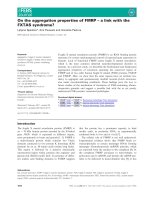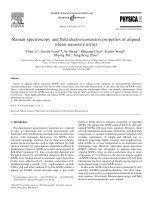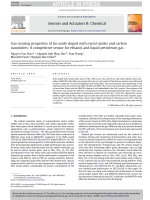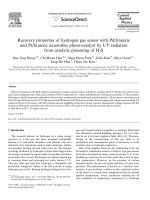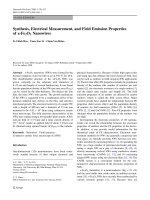- Trang chủ >>
- Khoa Học Tự Nhiên >>
- Vật lý
PROPERTIES OF YANG MILLS FIELD WITH AXIALLY SYMMETRIC EXTERNAL COLOR CHARGE SOURCES
Bạn đang xem bản rút gọn của tài liệu. Xem và tải ngay bản đầy đủ của tài liệu tại đây (560.11 KB, 6 trang )
Proc. Natl. Conf. Theor. Phys. 37 (2012), pp. 187-192
PROPERTIES OF YANG-MILLS FIELD WITH AXIALLY
SYMMETRIC EXTERNAL COLOR CHARGE SOURCES
NGUYEN QUOC HOAN
Hanoi University of Science and Technology 1 Dai Co Viet Road, Hanoi 10000, Vietnam
Abstract. The physical characteristics of the solutions of Yang-Mills equations with
two point color charge sources and for topological indices n ≥ 2 are studied. The
space distributions of corresponding non-Abelian field strengths and energy density are
simulated and plotted. The dependence of the field strengths and the energy density on
topological indices is discussed. By using the same algorithm of solving, new solutions
for the Yang-Mills field due to a series of color point charges which lie in a straight
line are found and plotted explicitly. It is shown that the solutions for gauge potentials
and field energy have the form of vortex strings.
I. INTRODUCTION
For field equations of gauge theories there exist solutions, characterized by
nontrivial topological properties. They are called ”topological defects”, which
play an important role in particle physics and cosmology. Some examples are
monopoles (zero-dimensional defects), vortex strings (one-dimensional defects),
domain walls (two-dimensional defects). Since the systems of gauge field equations are coupled nonlinear differential equations of several field variables, the
solutions that have been found by analytical methods are only for some specific
cases of high symmetry properties. For example, the Wu-Yang monopole [1], ’t
Hooft-Polyakov monopole [2-4], instanton [5] solutions to the systems of YangMills and Yang-Mills-Higgs equations were found by virtue of using a spherically
symmetric ansatz. In general cases, for systems with lower symmetries, the integration of the corresponding field equations must be done numerically. Nowadays
different numerical methods are widely applied in order to discover more new solutions, and a lot of important solutions have been presented in the literature
(see, for example, [6]-[9]).
Much attention have been paid also to the solutions to the systems of the
Yang-Mills fields coupled to external sources. Notable are the charge screening
solutions and the magnetic dipole solutions by Sikivie , Weiss [10], the type-I and
type-II solutions by Jackiw, Jacobs, Rebbi [11]. The solutions carry an gaugeinvariant topological index, identified with the magnetic charge. The solutions
to the Yang-Mills fields with axial-symmetric external sources and with higher
topological indices were constructed in Refs. [12],[13].
The problem of the Yang-Mills field equations with two color point charges
and higher topological indices (n ≥ 2) has been investigated in Ref. [14], where
the solutions to the field equations were found numerically by the relaxation
188
NGUYEN QUOC HOAN
method [15]. In the present paper, some physical characteristics of the solutions
obtained in [14] are studied in more details. Namely, the space distributions of
the non-Abelian ”electric”, ”magnetic” field and field energy density are simulated and plotted for the cases n = 2 and n = 3. The results show explicitly the
dependence of the field and energy on the topological index (Sec. II). Furthermore, by the same algorithm for solving, as in Ref. [14], new solutions for the
case of a series of color point charges located in a straight line are exhibited (Sec.
III). In Section IV, Conclusion, a discussion is given about the obtained results.
II. PROPERTIES OF THE YANG-MILLS FIELDS WITH TWO
POINT COLOR CHARGE SOURCES
The SU (2) Yang-Mills equations in the presence of an external static source
is
Dµ F µνa = j νa ,
where
j νa
(1)
is the non-Abelian color charge external static source current, and
F µν = ∂µ Aaν − ∂ν Aaµ + gf abc Abµ Acν
(2)
is the non-Abelian field strength tensor of electrodynamics. In Eq. (2) g is the
gauge field coupling constant. Here we shall set g = 1, and the restoration can
be done by a rescaling with the coefficient 1/g for potentials and field strengths
and 1/g 2 for Lagrangian and energy.
For the external sources with two point color charges the system possesses
axial symmetry. By applying the axial-symmetric ansatz for the Yang-Mills potentials in Refs. [12], [13], the Lagrangian functional for the Yang-Mills equations
with two point color charges is reduced to the following form in cylindrical coordinates [14]
∞
L=π
+∞
ρdρ
Φn
∂ρ
2
+
Φn
∂z
2
−
An
∂ρ
2
+
dz×
−∞
0
An
∂z
2
+ Φ2n An −
n
ρ
−QΦn (ρ = 0, z = a) + QΦn (ρ = 0, z = −a),
2
−
An
ρ
2
(3)
In Eqs. (3) (ρ = 0, z = ±a) are the coordinates of two point sources, An (ρ, z),
Φn (ρ, z) are the field profiles, n is the topological index of the solution, which
defines which homotopy class the solution belongs to. The numerical solutions
are equilibrium gauge configurations for Lagrangian (3) and can be found by
the relaxation method [15]. The schema of discretization and minimization for
Lagrangian (3), as well as the results for the case n = 2 were presented in Ref.
[14]. Here we find the solutions for the case of n = 3, 4, and then calculate and
plot explicitly the corresponding electric, magnetic non-Abelian field strengths
and the energy density.
The expression for the non-Abelian electric field vector is
Enai = F a0i = − δ a1 cos(nϕ) + δ a2 sin(nϕ) ∂ i Φn
PROPERTIES OF YANG-MILLS FIELD WITH ...
189
Fig. 1. The 3D-plot of the non-Abelian electric field vector En1 for n = 2
(left) and for n = 3 (right)
− δ a2 cos(nϕ) − δ a1 sin(nϕ)eφ Φn
An −
n
.
ρ
(4)
Substituting the obtained numerical solutions for the field profiles An (ρ, z),
Fig. 2. The field lines of the non-Abelian magnetic field vector component Bn3 (ρ, z) for n = 2 (left) and for n = 3 (right)
Φn (ρ, z), one has the numerical values for Enai . The 3D-plots of the electric field
vector (transformed to Cartesian coordinates) for the component with a = 1,
and two different indices n = 2 and n = 3 are given in Fig. 1, for illustration.
Hereafter the numerical value of the charge parameter is taken Q = 3.
190
NGUYEN QUOC HOAN
The non-Abelian magnetic field is given by
1
a
Bnai = εijk Fjk
= δ3a εijk ∂j (An ϕˆk ) ,
(5)
2
where ϕˆ is the unit vector of coordinate ϕ. Note that the magnetic field vectors
lie in the (ρ, z)-plane, and it is better to observe the magnetic field lines in this
plane (see Fig. 2).
The plots of the field energy density
n
1
(∇Φn )2 + Φ2n An −
2
ρ
for the cases n = 2 and n = 3 are presented in Fig. 3.
H = 2πρ
2
,
(6)
Fig. 3. The distributions of non-abelian fields energy density H n (ρ, z)
in plane (ρ, z), for n = 2 (left) and for n = 3 (right)
Figures 1, 2, 3 give a visual concept about the Yang-Mills field solutions,
and their dependence on topological index n. One can see that when the picture
of non-Abelian electric and magnetic field vectors changes slowly as increasing n,
the fields, and in particular, the field energy density have a remarkable change in
magnitude. For example, the magnitude of the energy maximum in the case of
n = 3 is smaller than that for n = 2 in about 20 times.
III. YANG-MILLS FIELD SOLUTIONS WITH SERIES OF POINT
COLOR CHARGES LOCATED IN A STRAIGHT LINE
By using the same algorithm of solving, the Yang-Mills field solutions for
the case of the sources which have the form of a series of point color charge are
obtained. We have changed the last two term in Lagrangian functional (3) into
−
QΦn (ρ = 0, z = na), n = 0, ±1, ±2, ...
(7)
n
and performed the calculation in FOTRAN programming. The obtained results for the gauge potentials and the corresponding energy density become zindependent. The plots of the profile functions for gauge potentials Φn and An ,
as functions of only coordinate ρ, are given in Figures 4, where parameter Q is
PROPERTIES OF YANG-MILLS FIELD WITH ...
191
taken, as before, to be Q = 3. The distributions of non-abelian fields energy
density H n (ρ, z) in plane (ρ, z) are shown in Fig. 5.
Fig. 4. The profile functions Φn (ρ) - red solid curve, An (ρ) - dashed
curve for n = 2 (left) and for n = 3 (right)
Fig. 5. The distributions of the non-abelian fields energy density
H n (ρ, z) H n (ρ, z) in plane (ρ, z), for n = 2 (left) and for n = 3 (right)
It is seen that the solutions for the gauge potentials and the energy density have the form of a vortex. The results of calculation for different values of
parameter Q and of index n show that the global extrema of the gauge potentials
and the energy density increase fast with Q and decrease with increasing n.
IV. CONCLUSION
We have investigated static solutions of the SU (2) Yang-Mills theory with
external sources which have the form of two point color charges and then a series
of point color charges. The numerical calculations are obtained by solving the
system of two coupled non-linear partial differential equations for profile functions of the Yang-Mills potentials. For the case of two point color sources, the
dependence of non-Abelian gauge field strengths and energy density on topological indices and the parameter Q of color point charges have been discussed.
Some main conclusions are as follows: (i) The space distribution of of the nonAbelian gauge electric and magnetic changes when topological index n varies. (ii)
The magnitude of maxima of field strengths and energy increases with varying
parameter Q fast, and decrease with increasing topological index n.
192
NGUYEN QUOC HOAN
By numerical solutions for the Yang-Mills solutions in the case of external
sources that have the form of a series of point color charges, the results show the
vortex form of Yang-Mills potentials and energy density. These solutions provide
an example of vortex string configuration, the extended object which plays an
important role in particle and cosmology (see, for example,[16]).
ACKNOWLEDGMENT
The author wishes to acknowledge the help and suggestions of Prof. Nguyen
Vien Tho and To Ba Ha.
REFERENCES
[1] T. T. Wu and C. N. Yang, in ”Properties of Matter under Unusual Conditions,” ed. by K.
Mack and S. Fernhach (Interscience, New York (1969).
[2] G. ’tHooft, Nucl. Phys, B79 (1974) 276.
[3] A. M. Polyakov, JETP Lett, 20 (1974) 194.
[4] M. K. Prasad, C. M. Sommerfield, Phys. Rev. Lett, 35 (1975) 760.
[5] A. Belavin, A. Polyakov, A. Schwartz and Y.Tyupkin, Phys.Lett, 59B (1975) 85.
[6] B. Kleihaus, J. Kunz, Phys. Rev.D, 61 (2000) 025003.
[7] B. Kleihaus, J. Kunz and Ya. Shnir, Phys. Rev.D, 70 (2004) 065010.
[8] V. Paturyan, D. H. Tchrakian, J. Math. Phys., 45 (2004) 302.
[9] L. G. Androvandi, Phys. Rev.D, 76 (2007) 085015.
[10] P. Sikivie, N. Weiss, Phys. Rev. Lett. B, 40 (1978) 1411.
[11] R. Jackiw, L. Jacobs, and C. Rebbi Phys. Rev.D, 20 (1979) 474.
[12] M. P. Isidro Filho, A. K. Kerman, H. D. Troittier Phys. Rev.D, 40 (1989) 4142.
[13] C. H. Oh Phys. Rev.D, 47 (1993) 1652.
[14] N. V. Tho, T. B. Ha and N. Q. Hoan, Proc. Nat. Conf. Theor. Phys, 35 (2010) 80.
[15] S. L. Adler, T. Piran, Phys. Rev.D, 56 (1984) 1.
[16] A. Vilenkin and E. P. S. Shellard, Cosmic String and Other topological Defects, Cambridge
University Press, Cambridge, (2000)


